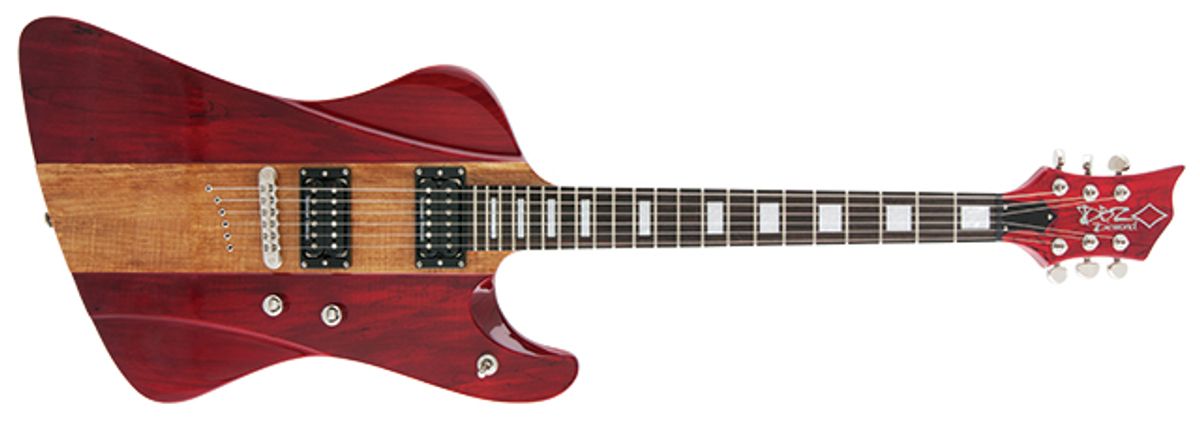
Since launching in 2008, DBZ Guitars has introduced some of the most eye-catching instruments in the industry, quickly garnering the attention of players like John Corabi, Kid Rock’s Jason
Since launching in 2008, DBZ Guitars has introduced some of the most eye-catching instruments in the industry, quickly garnering the attention of players like John Corabi, Kid Rock’s Jason Krause, Train’s Jerry Becker, Kelly Pickler’s Josh Henson and the late Mike Scaccia of Ministry. The company’s latest lineup, rebranded DBZ/Diamond Guitars and launched at NAMM ’13, features three new streamlined headstock designs and several new models designed by DBZ/Diamond Founder, President and CEO, Jeff Diamant—also the man behind Diamond Amplification.
Among the new models is the Hailfire series, a cool twist on the Firebird/RD Artist template. And though it might not be as radical looking as other DBZs we’ve seen in the past, it packs a lot of bold style and authoritative tone in a relatively affordable axe. The series includes two models—the solid-mahogany Hailfire ST and the Hailfire SM reviewed here, which features though-body stringing, upgraded pickups, spalted maple top and flashier finishes.
Bird of Prey
The Hailfire’s debt to the Firebird is obvious both in its body profile and the raised center section. The construction, however, is very different from a Firebird. Instead of a multi-ply walnut neck-through design, the Hailfire SM is built with a relatively light mahogany body that’s capped with a dramatically carved and striking spalted-maple top. Its painted wings and raised, natural center area give the illusion that it’s a neck-through model, but in reality the guitar’s 22-fret, rosewood-capped mahogany neck uses set-neck construction and a contoured heel that enables access to the upper frets.
In terms of hardware and electronics, the Hailfire keeps things pretty lean. The through-body stringing negates the need for a tailpiece and improves sustain, and a Tune-o-matic-style bridge and Grover tuners help you keep intonation correct and the guitar in tune. Two Seymour Duncan humbuckers—a ’59 in the neck and a JB in the bridge—are responsible for the guitar’s considerable output. Both pickups are controlled by a 3-way switch and master volume and tone controls. This setup is nice and streamlined, though it may be limiting for players who like to switch between, say, a super-dark neck-pickup sound and a bright, spunky bridge pickup.
Open Fire
After warming up a Mesa/Boogie Dual Rectifier half-stack and strapping on the Hailfire, I was blown away by how light the guitar is. At a hair over 6 pounds, it doesn't put as much strain on your shoulder as most guitars of this size—and nowhere near as much as your typical maple-capped mahogany guitars. The neck-to-body balance is pretty even, too, and the weight of the headstock doesn't pull the neck down to the floor when standing.
Ratings
Pros: Light and comfortable. Tried-and-true Duncan pickup combo offers a plethora of tones. Wide neck eases simple and complex chording.
Cons: Master volume and tone controls might be limiting to some. Bridge position gets muddy with a lot of gain. Shredders might prefer a narrower neck.
Tones:
Playability:
Build/Design:
Value:
Street: $849
DBZ/Diamond
dbzguitars.com
Most players know of the huge tonal range you can get by combining a Duncan '59 and JB model—it’s one of the most popular humbucker combinations on the planet—and they live up to their considerable reputation in the Hailfire SM. The neck pickup produces super-smooth mids and thick, even lows for jazzy clean work, and digging in coaxes out a rich high end without any harsh edginess. When output is clean or colored by slight overdrive, the neck pickup has a response and warm array of tones that are very similar to a Gibson SG, but with tighter, more focused mids and highs (a point that is likely attributable in part to the Hailfire's maple top). The neck's slightly wider feel toward the headstock makes chords comfortable, but it’s a little tougher to pull off lightning-quick legato leads and clean, string-skipping melodies.
With light to moderate overdrive, the Hailfire SM yields a muscular array of rhythm and lead tones. The JB's characteristic detailed highs cut like a knife, and its raw midrange and thick low end provide a solid foundation for everything from classic-rock rhythms to late-’80s hard-rock riffing. Turning up the gain on my Mesa's orange channel added a little congestion in the midrange and dampened the presence a touch, and I experienced the same problem after switching over to a more mid-heavy Marshall JCM800. So when using the Hailfire's bridge pickup for heavier tones, it's best to set the amp's gain right at the point where the tone is both saturated and balanced, and then to use the amp's EQ to add low-end punch and more blistering highs.
The Verdict
The DBZ/Diamond Hailfire SM is solid guitar capable of covering much more musical ground than its flashy looks might suggest. Its lightweight, balanced construction alone make it a winner in a world that's constantly demanding lighter, more comfortable guitars, and the solid build and pickup complement are capable of handling everything from jazz to rock, blues, country, metal, and beyond. Shredders might prefer a narrower neck, but if you're in the market for a guitar with hot-rodded tone and custom looks to match—and at a pretty damn reasonable price—the DBZ/Diamond Hailfire SM offers a lot of compelling selling points.

